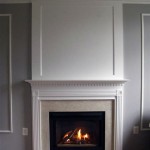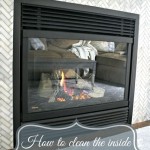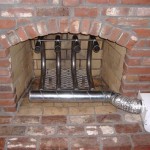Understanding Fireplace Insert Blowers: Enhancing Heating Efficiency
Fireplace insert blowers are devices designed to significantly enhance the heating efficiency of fireplace inserts. Fireplace inserts, essentially enclosed stoves designed to fit within an existing fireplace opening, offer a more controlled and efficient heat source compared to traditional open fireplaces. However, even with an insert, a significant portion of the heat can still be lost up the chimney if not properly circulated. This is where a blower comes into play, acting as a forced-air convection system to distribute the heat more effectively throughout the room and surrounding areas.
A standard fireplace insert without a blower relies primarily on radiant heat, which warms objects directly in its line of sight. While radiant heat provides immediate warmth, it's not as efficient at heating the entire space evenly. The air surrounding the insert tends to heat up, creating a thermal gradient with warmer air rising to the ceiling and cooler air remaining near the floor. This can lead to discomfort and inefficient fuel consumption as the heating system struggles to maintain a consistent temperature.
The installation of a fireplace insert blower mitigates these issues by actively drawing cool air from the room, passing it over the heated surfaces of the insert, and then blowing the warmed air back into the room. This forced-air circulation ensures that the heated air is distributed more evenly, reducing temperature stratification and improving overall comfort. This article will delve into the mechanics, benefits, types, and considerations surrounding fireplace insert blowers.
Key Benefits of Using a Fireplace Insert Blower
The primary advantage of incorporating a blower into a fireplace insert system is the improved heating efficiency. By actively circulating air, the blower maximizes the heat output from the insert, reducing the amount of fuel needed to maintain a desired temperature. This translates to significant cost savings over time, especially for individuals who rely on their fireplace insert as a primary or supplemental heating source.
Beyond cost savings, a blower provides a more comfortable and consistent heating experience. Without a blower, the heat from an insert tends to concentrate near the unit, leaving other areas of the room relatively cool. With a blower, the warmed air is circulated throughout the room, eliminating cold spots and creating a more uniform temperature distribution. This makes the living space more comfortable and inviting, especially during colder months.
Furthermore, the improved heating efficiency provided by a blower can contribute to environmental benefits. By reducing fuel consumption, the blower helps to lower the overall carbon footprint of the heating system. This is particularly relevant for wood-burning inserts, where reduced wood consumption minimizes emissions of particulate matter and other pollutants. In contrast, gas inserts see a reduction in gas usage which decreases the emission of greenhouse gasses.
Types of Fireplace Insert Blowers
Fireplace insert blowers come in various designs and configurations, each with its own advantages and disadvantages. The selection of an appropriate blower depends on the specific model of the fireplace insert, the desired level of performance, and the available budget. It's crucial to choose a blower that is specifically designed and compatible with the insert to ensure proper functionality and safety.
One common type is the tangential blower, also known as a squirrel cage blower. These blowers feature a cylindrical impeller with multiple blades that rotate within a housing. Tangential blowers are known for their quiet operation and ability to move a large volume of air at a relatively low pressure. This makes them well-suited for fireplace inserts, where noise levels are a concern.
Another type is the centrifugal blower, which uses a rotating impeller with curved blades to generate airflow. Centrifugal blowers are typically more powerful than tangential blowers and can deliver air at a higher pressure. While they may be slightly noisier, centrifugal blowers are often preferred for larger fireplace inserts or those requiring more robust airflow to heat larger spaces.
In addition to the blower type, there are also variations in the control mechanisms. Some blowers operate at a fixed speed, while others have variable speed controls that allow the user to adjust the airflow based on the desired heating output. Variable speed blowers offer greater flexibility and control, allowing for fine-tuning of the heating performance and noise levels.
Some newer models even incorporate thermostatic controls. These blowers automatically adjust their speed based on the temperature of the fireplace insert, providing hands-free operation and optimizing energy efficiency. The thermostat monitors the insert's temperature and increases the blower speed as the insert heats up, and decreases the speed as it cools down.
Key Considerations When Choosing and Installing a Fireplace Insert Blower
Before purchasing a fireplace insert blower, it's essential to verify compatibility with the specific fireplace insert model. Many manufacturers offer blowers that are specifically designed to fit their inserts, ensuring proper installation and optimal performance. Using a non-compatible blower could potentially damage the insert or compromise its heating efficiency, and potentially void any warranties in place.
The required airflow capacity of the blower depends on the size of the fireplace insert and the area to be heated. A larger insert or a larger room will require a blower with a higher CFM (cubic feet per minute) rating to effectively circulate the air. Consulting the insert's manufacturer or a qualified HVAC technician can help determine the appropriate CFM rating for the specific application.
Installation of the blower should be performed by a qualified technician or a experienced DIY enthusiast. The process typically involves removing the insert from the fireplace opening, installing the blower into the designated compartment, and connecting the electrical wiring. It's crucial to follow the manufacturer's instructions carefully to ensure proper installation and avoid any safety hazards. Improper wiring can lead to fire hazards or damage to the blower or the insert.
Noise levels are also an important consideration, especially for bedrooms or living rooms where quiet operation is desired. Some blowers are inherently quieter than others, and factors such as the blower type, speed, and mounting location can all influence the noise level. Reading reviews and comparing specifications can help in selecting a blower that offers a balance between performance and quietness.
Regular maintenance is crucial for ensuring the longevity and optimal performance of the fireplace insert blower. This typically involves cleaning the blower fan blades and housing to remove dust and debris that can accumulate over time. Clogged blowers operate less efficiently and can overheat, leading to premature failure. Checking the electrical connections and ensuring that they are secure is also important for safety.
Power consumption is another aspect to consider, although many modern blowers are designed to be energy-efficient. It’s wise to review the blower's wattage rating to understand its impact on the electricity bill, especially if the fireplace insert is used frequently during the heating season.
Finally, consider the features of the blower, such as variable speed control, thermostatic operation, and remote control functionality. These features can enhance the user experience and provide greater control over the heating performance of the fireplace insert while also adding to the overall cost. It’s best to consider your needs and balance them with the budget.
By carefully considering these factors, individuals can select and install a fireplace insert blower that will effectively enhance the heating efficiency of their insert, improve comfort, and reduce fuel consumption, making their home a warmer and more efficient living space.

Fireplace Efficiency Blowers And Why You Should Have One

Why Should I Get A Fireplace Blower For My Masonry

Ventis Wood Burning Fireplace Insert With Blower Hei170 Hvacdirect Com

35 Ruby Traditional Intellifire Touch Direct Vent Fireplace Insert Blower And Remote Electronic Ignition Majestic

How To Buy A Gas Fireplace Insert Buyer S Guide From Regency

Wood Fireplace Inserts With Blowers Upgrade Your

Fireplace Blowers Explained How Fans Work Regency

Fireplace Blower Fans What You Need For Heat Full Service Chimney

Wood Burning Fireplace Insert With Blower Blowers Inserts

Best Wood Burning Fireplace Insert With Blower Forestry Reviews
Related Posts








